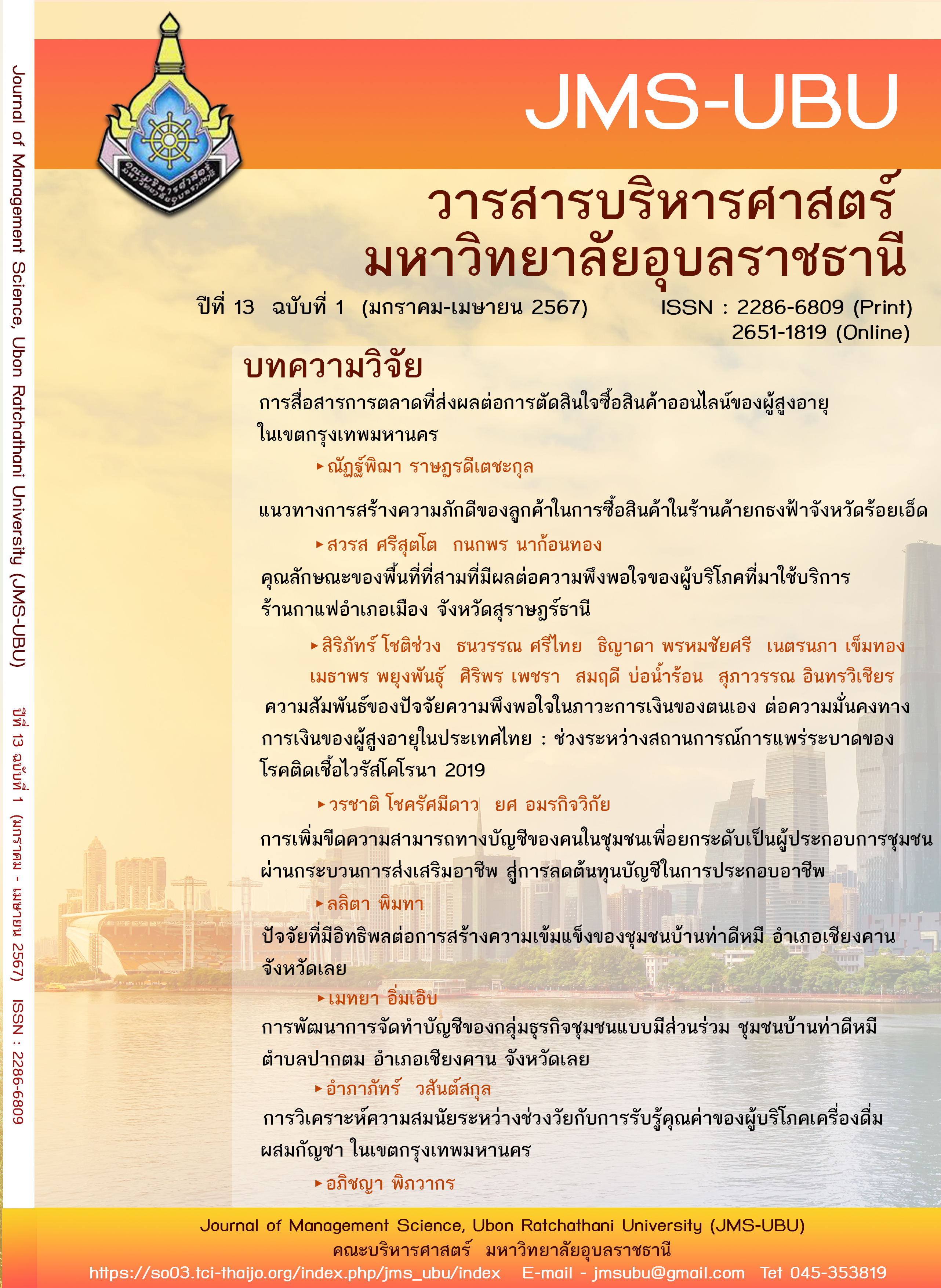Factors Influencing the Community Strength in Ban Tha Di Mi, Chiangkhan District, Loei Province
Main Article Content
Abstract
The process of strengthening the community comes from the concept of foundation development. As the community is an important social foundation, the strength of the community should be developed by creating new knowledge through the transfer, exchange, and learning between people in the community. The purposes of this study were: 1) to study the conditions and problems affecting the strength of the community in Ban Tha Di Mi, Chiangkhan District, Loei Province; 2) to study the level of factors that influence the strength of the community in Ban Tha Di Mi, Chiangkhan District, Loei Province; and 3) to study factors that influence the strengthening of the community in Ban Tha Di Mi, Chiangkhan District, Loei Province. A mixed method was used in this study, with a sample of 285 people living in Ban Tha Di Mi, Chiangkhan District, Loei Province. The collected data were analyzed using statistical methods, including frequency distribution, percentage, mean and standard deviation calculation, and multiple regression analysis with a significance level of 0.05.
The research showed factors influencing the strength of the Ban Tha Di Mi community in Chiang Khan District, Loei Province, overall are at a high level. Classified by personal factors, opinions on knowledge management factors and community strengthening were overall at a high level. Results of multiple regression analysis indicated that knowledge management was correlated with community strength with an adjusted R2 of 0.649, implying that the model's prediction was 64.90% at a significant level of 0.05. To set a policy for strengthening the community, the people in the community should be involved in the planning process. Moreover, local organizations should support the use of technology for strengthening the community.
Downloads
Article Details

This work is licensed under a Creative Commons Attribution-NonCommercial-NoDerivatives 4.0 International License.
References
กัลยา วานิชย์บัญชา. (2549). การวิเคราะห์สถิติ: สถิติสำหรับการบริหารและวิจัย. กรุงเทพฯ: จุฬาลงกรณ์มหาวิทยาลัย.
จักรธร พลคชา. (2563). ปัจจัยที่ส่งผลต่อความเข็มแข็งของชุมชนในเขตเทศบาลตำบลเสลภูมิ อำเภอเสลภูมิ จังหวัดร้อยเอ็ด. (วิทยานิพนธ์ปริญญามหาบัณฑิต). มหาวิทยาลัยราชภัฏมหาสารคาม, คณะรัฐศาสตร์และรัฐประศาสนศาสตร์.
จังหวัดเลย. (2561). ข้อมูลทั่วไปของแต่ละอำเภอ. สืบค้นเมื่อ 12 มกราคม 2564, จาก https://ww2.loei.go.th/amphur_content
จินดารัตน์ ทรัพย์เจริญ, ธนพร สุขแก้ว, นริสรา ชะระตะคุ, นารีรัตน์ สบายดี, บัวชมพู เกตชิต, พรทิพย์ วังสันต์, . . . กิตติวินท์ เอี่ยมวิริยะวัฒน์. (2563). ปัจจัยที่ส่งผลต่อความสำเร็จในการเป็นหมู่บ้านท่องเที่ยว กรณีศึกษาบ้านสนวนนอก ตำบลสนวน อำเภอห้วยราช จังหวัดบุรีรัมย์ (รายงานวิจัย). บุรีรัมย์: มหาวิทยาลัยราชภัฏบุรีรัมย์.
ดำรงศักดิ์ แก้วเพ็ง. (2556). ชุมชน. สงขลา: นำศิลป์โฆษณา.
ทิพวรรณ หล่อสุวรรณรัตน์. (2548). องค์การแห่งความรู้: จากแนวคิดสู่การปฏิบัติ. กรุงเทพฯ: แซท์โฟร์ พริ้นติ้ง จำกัด.
นภาภรณ์ หะวานนท์, เพ็ญสิริ จีระเดชากุล, สุระวุฒิ ปัดไธสง, อุษณีย์ ธโนศวรรย์, โสมพรรณ ถิ่นว่อง, ศศิธร ศิริประเสริฐกุล, . . . ฉัตรวรัญ องคสิงห์. (2550). ทฤษฎีฐานรากในเรื่องความเข้มแข็งของชุมชน. กรุงเทพฯ: สำนักงานกองทุนสนับสนุนการวิจัย (สกว.).
น้ำทิพย์ วิภาวิน. (2547). การจัดการความรู้กับคลังความรู้. กรุงเทพฯ: เอสอาร์ พรินติง แมส โปรดักส์ จำกัด.
บุญดี บุญญากิจ และคณะ. (2547). การจัดการความรู้ ทฤษฎีสู่การปฏิบัติ. กรุงเทพฯ: จิรวัฒน์ เอ็กเพรส.
ปรีชา วงศ์ทิพย์. (2555). การพัฒนาชุมชนประยุกต์: แนวคิดการบูรณาการ. กรุงเทพฯ: สถาบันเสริมสร้างการเรียนรู้เพื่อชุมชนเป็นสุข (สรส.).
ปาริชาติ วลัยเสถียร. (2549) กระบวนการเรียนรู้และจัดการความรู้ของชุมชน (รายงานวิจัย). กรุงเทพฯ: มหาวิทยาลัยธรรมศาสตร์.
รพีภัทร์ สุขสมเกษม. (2559). ปัจจัยที่มีผลต่อการส่งเสริมความเข้มแข็งของชุมชน กรณีศึกษาชุมชนในเขตเทศบาลนครปากเกร็ด จังหวัดนนทบุรี. (การค้นคว้าอิสระปริญญามหาบัณฑิต). มหาวิทยาลัยธรรมศาสตร์, คณะรัฐศาสตร์.
วิสิทธิ์ ยิ้มแย้ม และ อุษณากร ทาวะรมย์. (2561). ปัจจัยที่ส่งผลต่อความเข้มแข็งของชุมชนหมู่บ้านเศรษฐกิจพอเพียงต้นแบบ อำเภอเกาะจันทร์ จังหวัดชลบุรี. วารสารวิชาการศิลปศาสตร์ประยุกต์, 11(1), 39-50.
สถาบันเพิ่มผลผลิตแห่งชาติ. (2547). การจัดการความรู้จากทฤษฎีสู่การปฏิบัติ. กรุงเทพฯ: จิรวัฒน์ เอ็กเพรส
สนธยา พลศรี. (2550). เครือข่ายการเรียนรู้ในงานพัฒนาชุมชน (พิมพ์ครั้งที่ 2). กรุงเทพฯ: โอเดียนสโตร์.
สํานักงานสถิติแห่งชาติ. (2560). รายงานสถิติประชากรและเคหะ. สืบค้นเมื่อ 21 กุมภาพันธ์ 2560, จาก http://service.nso.go.th/nso/nsopublish/themes/population.html
สำนักงานคณะกรรมการพัฒนาการเศรษฐกิจและสังคมแห่งชาติ. (2559). แผนพัฒนาเศรษฐกิจและสังคมแห่งชาติ ฉบับที่สิบสอง พ.ศ. 2560-2564. กรุงเทพฯ: สำนักนายกรัฐมนตรี.
อนันตพร ภูกิ่งหิน. (2550). ความสัมพันธ์ระหว่างการจัดการความรู้กับผลการดำเนินงานของธุรกิจ SMEs ในจังหวัดกาฬสินธุ์. (วิทยานิพนธ์ปริญญามหาบัณฑิต). มหาวิทยาลัยมหาสารคาม, สาขาวิชาบริหารธุรกิจ.
อนุชาติ พวงสาลี และ วีรบูรณ์ วิสารทสกุล. (2541). ประชาสังคม: คำ ความคิดและความหมาย. กรุงเทพฯ: สถาบันชุมชนท้องถิ่นพัฒนา.
Dalkir, K. (2005). Knowledge Management in Theory and Practice. Montreal: McGill University.
De Long, D. W., & Fahey, L. (2000). Diagnosing cultural barriers to knowledge management. Academy of Management Executive, 14(4), 113-127.
Desouza, K. C., & Awazu, Y. (2006). Knowledge management at SMEs: Five peculiarities. Journal of Knowledge Management, 10(1), 32-43.
Hair, J. F., Black, W. C., Babin, B. J., & Anderson, R. E. (2010). Multivariate Data Analysis (7th ed.). New Jersey: Prentice Hall, Upper Saddle River.
Jennex, M. E., & Zynger, S. (2007). Security as a contributor to knowledge management success. Information Systems Frontiers, 9, 493-504.
Koulopoulos, T. M., & Frappaolo, C. (2000). Smart Things to Know about, Knowledge Management. Oxford: Capstone Publishing Limited.
Krejcie, R. V., & Morgan, D. W. (1970). Determining sample size for research activities. Educational and Psychological Measurement, 30(3), 607-610.
Marquardt, M. J. (1995). Building the Learning Organization: A Systems Approach to Quantum Improvement and Global Success. New York: McGraw-Hill.
Zack, M. H. (1999). Managing codified knowledge. Sloan Management Review, 40(4), 45-58.
